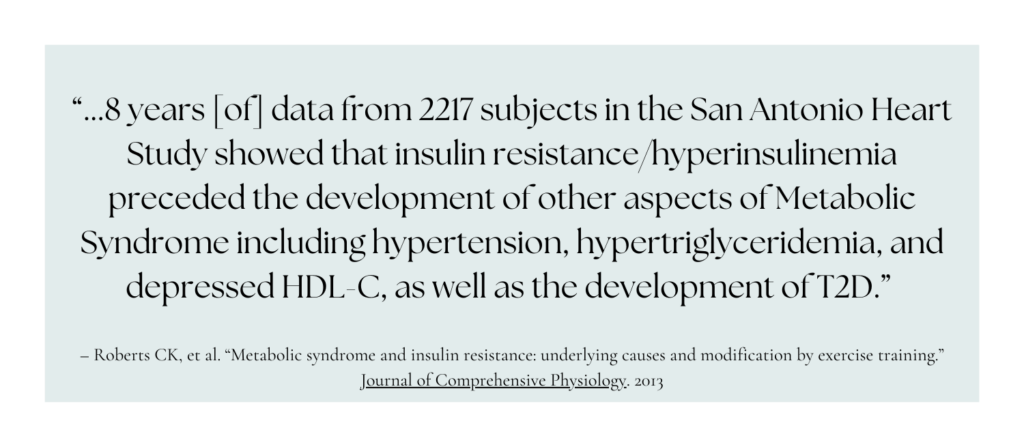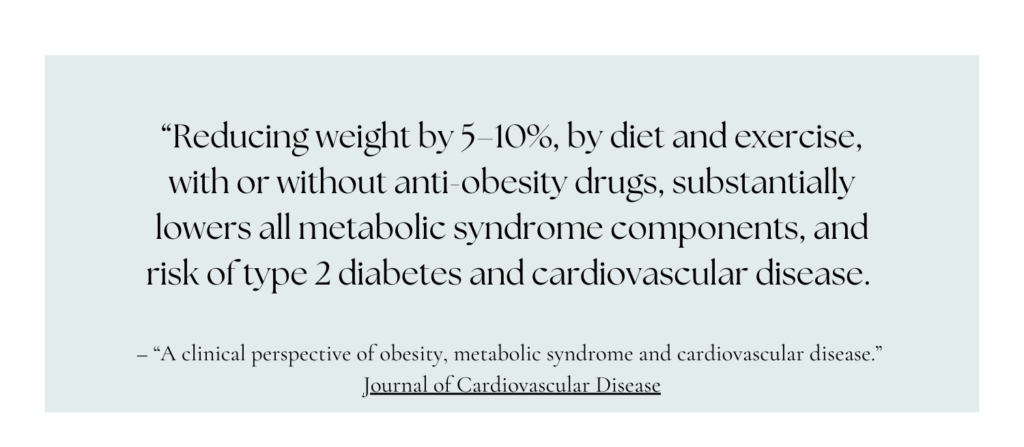Authored by Dr. Sarika Arora, MD
Metabolic Syndrome is a cluster of overlapping conditions that signal you are entering a danger zone for your health. MetS, as it is known medically, means that your body’s self-regulatory systems are breaking down, which will almost inevitably lead to one or more life-threatening disease states.
MetS affects about 35% of women and men, and its incidence is increasing. The condition is diagnosed when three or more of these five conditions occur:
- Insulin resistance
- Waist to hip ratio (or waist over 35”)
- High blood pressure (over 130/85)
- High triglycerides
- Low HDL (“good” cholesterol)
The odds of developing Metabolic Syndrome increase with age, simply because it’s a kind of accumulation of the effects of our health habits. Remarkably, conventional health providers often misdiagnose or completely overlook MetS. That’s tragic because there are so many things we can do to control or reverse Metabolic Syndrome.
Let’s start with understanding how it develops.
The trigger for metabolic syndrome? Insulin resistance
The science is clear that Metabolic Syndrome is rooted in insulin resistance, a condition in which the body’s cells don’t respond well to insulin, the master hormone responsible for regulating blood sugar. To compensate for decreased insulin sensitivity, the pancreas produces more insulin — a state known as hyperinsulinemia–to help process glucose from the foods we eat. Over time, dysregulation of this powerful hormone can disrupt multiple hormonal and body systems, leading to significant health issues.

Insulin resistance is most often driven by obesity, particularly when excess weight is concentrated around the midsection. Midsection weight – aka belly fat – is more than just an energy storage site; belly fat is visceral fat that releases hormones and inflammatory substances that can interfere with insulin’s role in the body, ultimately raising blood sugar and causing insulin resistance. Having a higher waist-to-hip ratio or “apple” shape is a clue that belly fat is creating hormonal interference in your health.
However, even women who aren’t overweight can develop insulin resistance due to lifestyle factors and high-sugar diets.
Figure A. Levels of insulin needed by healthy adult volunteers to metabolize blood glucose after taking an Oral Glucose Tolerance Test. Source: Weight of the Nation Conference, 2018.
The chart above shows that over the past few decades, the amount of insulin our bodies need to metabolize glucose has dramatically increased, even among otherwise “healthy” adults. Why? The ultra-processed foods that make up the Standard American Diet are filled with sugar and other refined carbohydrates, which cause rapid spikes in blood glucose. This repeated glucose load forces the pancreas to keep pumping out insulin, until cells become less and less responsive.
Insulin resistance affects over time
Over time, insulin resistance causes impaired functioning of fat cells, particularly in the abdominal visceral fat, further reducing sensitivity to insulin signaling and increasing the number of these fat cells. This malfunction creates a damaging feedback loop, particularly for women in the menopause transition as hormonal fluctuations amplify insulin resistance and its effects.
As insulin resistance builds, the chronic inflammatory state it produces sets off a cascade of further negative effects, including progressive injury to the inner lining of blood vessels and to organs and tissues throughout the body. This can trigger high blood pressure, elevated triglycerides and lowered levels of HDL cholesterol (the “good” cholesterol).
Another driving force for metabolic syndrome? Chronic stress, which can also exacerbate this cycle by stimulating cortisol, a hormone that raises blood sugar and promotes visceral fat. Excess cortisol worsens metabolic syndrome symptoms and creates an even steeper uphill battle for metabolic health.
Metabolic syndrome creates long term risk, but also daily struggles
Once metabolic syndrome sets in, it unfortunately lays the groundwork for concerning health risks including type 2 diabetes and cardiovascular disease. According to the American Heart Association, people with metabolic syndrome are five times more likely to develop diabetes and twice as likely to suffer from cardiovascular disease. Studies also link metabolic syndrome with higher risks of certain cancers.
8 health problems directly related to MetS
- Cardiovascular disease
- Type 2 diabetes
- Nonalcoholic fatty liver disease (NAFLD)
- Chronic kidney disease
- Increased risk of cancer
- Sleep apnea
- Polycystic Ovary Syndrome (PCOS)
- Dementia and cognitive decline
But it’s not just about long term disease risk—metabolic syndrome can reduce energy levels, lower quality of life, and contribute to mood issues. The weight gain and health complications that accompany it can make women feel exhausted, discouraged and even hopeless.
Understanding these risks and recognizing the impact to your daily life is an empowering first step. After all, you can’t solve a problem when you don’t know what that problem is.
Well, now you know, so let’s go about getting you the answers you need to protect your health.
Breaking the cycle of metabolic syndrome

The most effective way to reverse metabolic syndrome is by losing weight. According to the Journal of Cardiovascular Disease, shedding just 5–10% of excess body weight can reduce insulin resistance, lower blood pressure, decrease inflammation, and improve cholesterol and triglyceride levels—all of which work together to reduce long-term risks for diabetes and cardiovascular disease.
While this is incredibly encouraging news, there is a frustrating twist: with Metabolic Syndrome, losing weight of any amount is much more challenging. Underlying insulin resistance, along with inflammation and stress, not only contribute to weight gain but can also create a state of weight loss resistance, in which metabolic imbalances cause the body to stubbornly hold onto weight.
So, if you think going on a crash diet for a few weeks will solve Metabolic Syndrome, don’t be surprised by what actually happens. In this state of weight loss resistance, traditional calorie restriction diets don’t work—and may even backfire by increasing stress on the body, further entrenching those stubborn pounds.
Achieving weight loss with metabolic syndrome is absolutely possible, but requires a different approach focused on balancing blood glucose, supporting insulin sensitivity, and adopting diet and lifestyle changes that allow the body to naturally release excess weight — helping to improve metabolic symptoms.
Steps to weight loss with metabolic syndrome
Here are some effective strategies that ease your body into a receptive state for weight loss:
Reduce sugar and refined carbohydrates
Start by reducing your intake of sugar and refined carbs, which spike blood sugar and insulin levels. Eliminate as much processed food as you can, which is often the prime source of refined carbs in the diet. When you do eat carbs, choose high-fiber foods that cause a slower release of glucose and support steady blood sugar. These “slow cards” include lentils, chickpeas, apples, berries and sweet potatoes.
Exercise regularly
Exercise is one of the best ways to improve insulin sensitivity and reduce inflammation. Even moderate activity, like brisk walking for 30 minutes a day, can make a big difference. Resistance training, including lifting weights or using resistance bands, can improve the way your body uses insulin.
Eat anti-inflammatory foods
Healthy foods like leafy greens, berries, nuts, and fatty fish are great for any weight loss diet because they can reduce the inflammation that often accompanies metabolic syndrome. Anti-inflammatory foods also support heart health and cholesterol balance.
Enhance metabolic support with natural supplements
Certain vitamins, minerals and natural plant compounds can provide help with managing blood sugar and boost metabolism, especially when combined with healthy lifestyle changes. Here are key supplements and their scientifically-supported benefits:
- Biotin: Plays a role in glucose and lipid metabolism, helping the body efficiently convert food into energy, which can improve insulin sensitivity over time.
- Magnesium: Assists in regulating insulin action and glucose uptake in cells, making it essential for maintaining stable blood sugar levels.
- Licorice Root: Contains compounds shown to support pancreatic health and may help regulate blood sugar levels by enhancing insulin sensitivity.
- Indian sphaeranthus and mangosteen extracts: These two botanicals are known in Ayurvedic medicine for their ability to support fat regulation.
- Green Tea Extract: Rich in antioxidants, especially EGCG, that protect cells from oxidative stress.
- Chromium: Known to improve insulin action and enhance glucose metabolism, chromium aids in reducing cravings and helps the body balance blood sugar levels.
Our Weight Loss + MetS Combo contains our exclusive M-Boost and Blood Sugar Balance formulas to deliver these herbs and nutrients for optimal metabolic health. M-Boost provides comprehensive support for fat regulation and fat-burning processes, while Blood Sugar Balance combines targeted minerals and bioactive compounds to enhance insulin sensitivity and glucose balance. Together, these formulas promote balanced blood sugar, improved insulin function, and efficient metabolism — helping you lose weight.
Practice Stress Management: Stress is a major player in weight loss resistance related to metabolic syndrome. Practice stress-relieving activities like yoga, meditation, deep breathing, grounding, or even just spending time in nature. Reducing stress can help lower cortisol levels and improve your body’s ability to lose weight.
Metabolic Syndrome is in your control
It’s completely understandable to feel overwhelmed when you have metabolic syndrome, but it doesn’t have to be the final chapter in your quest for good health. By paying attention to these early signs and taking action, you have the power to improve your health and well-being. With each healthy choice you make, you’re supporting your body’s ability to function well and thrive for years to come.
You’re not alone in this journey. We’re here to help you achieve your health goals.
References and further reading
Armani A, Berry A, Cirulli F, Caprio M. Molecular mechanisms underlying metabolic syndrome: the expanding role of the adipocyte. Faseb j 2017;31:4240–55.
Bergmann N, Gyntelberg F, Faber J. The appraisal of chronic stress and the development of the metabolic syndrome: a systematic review of prospective cohort studies. Endocr Connect 2014;3
–80.
Engin A. The Definition and Prevalence of Obesity and Metabolic Syndrome. Adv Exp Med Biol 2017;960:1–17.
Joseph M, Tincopa M, Walden P, et al. The Impact Of Structured Exercise Programs On Metabolic Syndrome And Its Components: A Systematic Review. Diabetes Metab Syndr Obes 2019;12:2395–404.
Ortiz M, Sapunar J. Longitudinal association between chronic psychological stress and metabolic syndrome. Rev Med Chil 2018;146:1278–85.
Ryan D, Yockey S. Weight Loss and Improvement in Comorbidity: Differences at 5%, 10%, 15%, and Over. Curr Obes Rep 2017;6:187–94.
Van Greevenbroek M, Schalkwijk C, Stehouwer C. Dysfunctional adipose tissue and low-grade inflammation in the management of the metabolic syndrome: current practices and future advances. F1000Res 2016;5.










